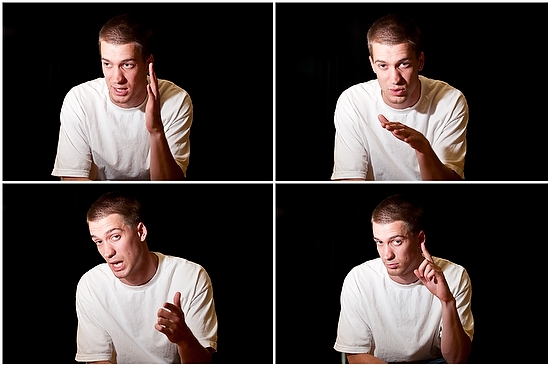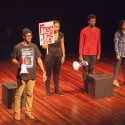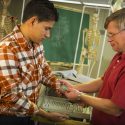Rafael Casal: Making the most of his fearlessness

Photo: Bryce Richter
He’s the professional artist who honed his craft and distilled his style at the University of Wisconsin–Madison for close to three years.
“I had a unique interest in language, and felt that it was the best tool/weapon for anyone looking to better themselves and their environment.”
Rafael Casal
Rafael Casal, 24, is an artist unique by many measures. He’s a non-traditional student who came here to work and decided to study. He taught for years before stepping into a formal university classroom and put a full-blown professional performance career on hold to come to Madison.
Call up Russell Simmons Def Jam Poets on YouTube and the same face that updated “On Wisconsin” with a rap version praising college life launches into a fierce spoken word performance that separates budding poets from those who’ve arrived. Casal arrived there a while ago.
This month, he’ll leave Wisconsin as a UW–Madison alum and head home to California to resume his life and his art – the same art that brought him to the university in the first place.
The music video for SPITTER by Rafael Casal.
“I was booked here three years ago to perform during Marc Bamuthi Joseph’s artist residency,” he says. “During his closing week, he invited some of his protégés to Madison to perform a showcase in front of his class, talk about their process, and be part of the dialogue of hip-hop on campus, and I was one of those “protégés.”
How Casal, who grew up in the San Francisco Bay area, became a protégé starts much earlier. By the time he reached high school, he was so disappointed with his teachers that he quietly slipped out a side door in his sophomore year – but not to hang out. He went across town to teach the art of spoken word to other teens.
“I was teaching writing workshops at other high schools while dropping out of my own,” Casal says. “I was really disappointed with teachers. I may have had maybe one good teacher. But they were all taking my education too casually. Over time, I’ve kept taking classes to feel I was progressing. Education is a major part of who I am because you can be a great artist, but if you don’t have a way to represent yourself it will go unnoticed.”
“I have been blessed with multiple opportunities here at UW both inside and outside of the classroom, both in the chair and at the board, to learn from truly brilliant people.”
He earned his high school diploma through an alternative program and built his own educational path, earning more than 50 credits of post-secondary work around a demanding travel schedule. Along the path, Casal has interned for filmmaker George Lucas and was mentored in the recording studios of the top musicians in the Bay area.
Working with Youth Speaks, the legendary project behind the Brave New Voices national youth spoken word festival, Casal entered the whirlwind circuit of touring, performing and teaching nationwide at 16 and was a full professional by age 18 plowing through 45 gigs a year.
“During my time performing and traveling, I spent six and a half years working in high schools,” he says. “With every performance I always had a component of workshops I would do in halfway houses or high schools, or community centers, working with younger folks who knew the attributes of the conditions that limited their potential, but could not articulate it through language. I had a unique interest in language, and felt that it was the best tool/weapon for anyone looking to better themselves and their environment.”
Madison was just another stop on that circuit.
“I remember three of my staff members were going to Madison to start a Youth Speaks chapter,” he says.
“There is more learning in teaching than in being a student, and so the classes I taught were the best classes I took. Here I professionalized what before I had improvised.”
Led by Josh Healey, who later went to California to work with Youth Speaks, the project evolved into the current high school outreach program overseen by the UW–Madison’s Office of Multicutural Arts Initiatives. Before leaving for the West Coast, Healey asked Casal to pick up the creative instruction in Madison with a fledgling college group called First Wave. He also introduced Casal to Chris Walker from the UW–Madison Dance Department and it sealed the deal.
“I wanted to work under the mentorship of Chris Walker,” Casal says. “I came here to work and build as the creative director of a new performing arts program at UW–Madison, and work with the top young writers and performers in the country. I wanted to see what I could do with students who wanted to be professional artists, professional activists and make positive contributions to their surroundings. To be clear, I came here to be a director first, and a student second.”
Casal carefully broke down his existence at UW–Madison.
“Socially – it has been nearly non-existent,” he says. “The reality is, working a 40-hour a week job, and carrying 15 units while navigating now nearly 60 students personalities, and fielding the skepticism of the public in regards to what I do (given my age) it has been a two-and-half-year life commitment. I knew this going in, and so it has not been a burden, just a fact.”
Academically, he says “so many people go through life never benefiting from the brilliance that is appropriate mentorship.”
“I have been blessed with multiple opportunities here at UW both inside and outside of the classroom, both in the chair and at the board, to learn from truly brilliant people. For that, the degree is simply a confirmation of that experience,” he says.
Casal also sees his experience in Madison – something he regards as a research period – through a professional lens.
“It is important that as a university program we exist in response to the popular mediums that young people are using/participating in to create their art.”
“There is more learning in teaching than in being a student, and so the classes I taught were the best classes I took. Here I professionalized what before I had improvised,” he says. “After nearly three years here, I have written almost four years’ worth of college level artistic curriculum, and directed or co-directed over 14 productions. I have also managed to get published in a few college textbooks and readers across the country. This is a new level of validation for my craft.”
Casal majored in sociology, a discipline he says has allowed him to observe and interpret the behavior of others. His work on campus and around the nation also allows him to size up the art of spoken word and its evolution.
“It is important that as a university program we exist in response to the popular mediums that young people are using/participating in to create their art. We should not be the authority, because the culture is youth-led, thus eliminating us from that capacity,” he says. “However, as a university program First Wave can provide resources and context through some traditional mediums to strengthen the foundation of what our students hope to accomplish through their own craft.”
I think it is important for students of color, or students from diverse populations and city settings, to bring those experiences to campus in full, just as students from small towns and largely rural areas of dense often white populations bring their perspectives in full to the conversation.
Some of the nation’s top contemporary artists have post-secondary training and college study or degrees, Casal said, which negates any public perception that the ranks of his colleagues are uneducated. Kanye West made a hit song out of dropping out because educators didn’t take him seriously as a student. Others include L.L. Cool J, Ludacris, Sean Combs, Ice Cube, Common, Lil Wayne, M.I.A., Paul Wall and current chart-topper Nicki Minaj attended a performing arts academy in New York City.
First Wave, he says, is a legitimate and valuable addition to the university community.
“I think it is important for students of color, or students from diverse populations and city settings, to bring those experiences to campus in full, just as students from small towns and largely rural areas of dense often white populations bring their perspectives in full to the conversation,” Casal says. “Unfortunately, it is the responsibility of my students and other students of color and of diverse social experiences to offer their perspectives in this structured space. I say unfortunately, because they are at an extreme minority, and so this is often a frustrating and painful uphill battle. However, my students are brought here as young leaders, and leadership is often about sacrifice. They sacrifice this inconvenience to create more space for other students like them to feel welcome and capable in university setting.”
Casal now faces life outside of the university setting – an adventure that he relishes.
“I’ve spent the last two years pursuing art, but mostly music, at 25 percent of my capacity, and have managed to gain a visibility and fan base that most artists who do this full time, have not,” he says. “So my next two years are about seeing what 100 percent truly feels like, and what response it earns me. Most people live in fear of what might happen if they put their all into something, I am taking advantage of my current fearlessness, while I still have the freedom to fall and recover.”



